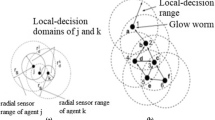Abstract
Wireless sensor networks consisting of numerous nodes function in such a manner that each node that collects data from its physical environment, conveys them to the base station for rigorous analysis. Maintaining the functional coverage, energy consumption and the lifetime are among the most challenging factors for WSN. The aim of this paper is to provide an effective coverage with a simultaneous reduction in energy consumption using mobile nodes and evolutionary firefly algorithm. The methodology involves dividing network area into equal cells though smaller size, in order to facilitate the estimation of the physical coverage. In areas with desirable and sufficient coverage, the operational scheduling of nodes is set in such a manner to activate some sensors to ensure necessary coverage and deactivate others. This, to a great extent, decreases the demand for energy. Under the circumstances where the cells are deprived of appropriate or sufficient coverage, mobile nodes are used to improve the coverage. This is achieved by using firefly algorithm to determine the optimum deployment of mobile nodes to perform the job. Results of simulation show that the proposed method has greater superiority over its comparative techniques, particularly on aspects such as the rate of network field area, energy consumption and network lifetime to mention a few.












Similar content being viewed by others
References
Rault, T., Bouabdallah, A., & Challal, Y. (2014). Energy efficiency in wireless sensor networks: A top-down survey. Computer Networks, 67, 104–122. https://doi.org/10.1016/j.comnet.2014.03.027.
Zhang, H., Huang, S., Jiang, C., Long, K., Leung, V. C. M., & Poor, H. V. (2017). Energy efficient user association and power allocation in millimeter-wave-based ultra dense networks with energy harvesting base stations. IEEE Journal on Selected Areas in Communications, 35(9), 1936–1947. https://doi.org/10.1109/JSAC.2017.2720898.
Zhang, H., Liu, H., Cheng, J., & Leung, V. C. M. (2017). Downlink energy efficiency of power allocation and wireless backhaul bandwidth allocation in heterogeneous small cell networks. IEEE transactions on communications, 66(4), 1705–1716. Retrieved from arXiv:1710.02942.
Zhu, C., Zheng, C., Shu, L., & Han, G. (2012). A survey on coverage and connectivity issues in wireless sensor networks. Journal of Network and Computer Applications, 35(2), 619–632.
Torkestani, J. (2013). An adaptive energy-efficient area coverage algorithm for wireless sensor networks. Ad Hoc Networks, 11(6), 1655–1666.
Fan, G., & Jin, S. (2010). Coverage problem in wireless sensor network: A survey. Journal of Networks, 5(9), 1033. https://doi.org/10.4304/jnw.5.9.1033-1040.
Savkin, A. V., Javed, F., & Matveev, A. S. (2012). Optimal distributed blanket coverage self-deployment of mobile wireless sensor networks. IEEE Communications Letters, 16(6), 949–951. https://doi.org/10.1109/LCOMM.2012.040912.110932.
Chen, A., Kumar, S., & Lai, T. H. (2010). Local barrier coverage in wireless sensor networks. IEEE Transactions on Mobile Computing, 9(4), 491–504.
Li, M., Cheng, W., & Liu, K. (2011). Sweep coverage with mobile sensors. IEEE Transactions on Mobile Computing, 10(11), 1534–1545.
Mohamadi, H., Salleh, S., Razali, M. N., & Marouf, S. (2015). A new learning automata-based approach for maximizing network lifetime in wireless sensor networks with adjustable sensing ranges. Neurocomputing, 153, 11–19. https://doi.org/10.1016/j.neucom.2014.11.056.
Rakavi, A., Manikandan, M. S. K., & Hariharan, K. (2015, March). Grid based mobile sensor node deployment for improving area coverage in wireless sensor networks. In 2015 3rd international conference on signal processing, communication and networking (ICSCN) (pp. 1–5). IEEE.
Xiong, Z., Wang, B., & Wang, Z. (2016). Priority-based greedy scheduling for confident information coverage in energy harvesting wireless sensor networks. In Proceedings—11th international conference on mobile ad-hoc and sensor networks, MSN 2015 (pp. 18–22). IEEE. https://doi.org/10.1109/MSN.2015.20.
Mini, S., Udgata, S. K., & Sabat, S. L. (2014). Sensor deployment and scheduling for target coverage problem in wireless sensor networks. IEEE Sensors Journal, 14(3), 636–644.
Yang, C., & Chin, K. W. (2014). Novel algorithms for complete targets coverage in energy harvesting wireless sensor networks. IEEE Communications Letters, 18(1), 118–121. https://doi.org/10.1109/LCOMM.2013.111513.132436.
Wan, Z. G., Tan, Y. K., & Yuen, C. (2011). Review on energy harvesting and energy management for sustainable wireless sensor networks. In 2011 IEEE 13th international conference on communication technology (pp. 362–367). IEEE. https://doi.org/10.1109/ICCT.2011.6157897.
Hu, C., & Wang, Y. (2014). Schedulability decision of charging missions in wireless rechargeable sensor networks. In 2014 11th annual IEEE international conference on sensing, communication, and networking, SECON 2014 (pp. 450–458). IEEE. https://doi.org/10.1109/SAHCN.2014.6990383.
Das, P. P., Chakraborty, N., & Allayear, S. M. (2015). Optimal coverage of wireless sensor network using termite colony optimization algorithm. In 2015 international conference on electrical engineering and information communication technology (ICEEICT) (pp. 1–6). IEEE.
Gupta, S. K., Kuila, P., & Jana, P. K. (2016). Genetic algorithm approach for k-coverage and m-connected node placement in target based wireless sensor networks. Computers and Electrical Engineering, 56, 544–556. https://doi.org/10.1016/j.compeleceng.2015.11.009.
Zhang, Y., Sun, X., & Wang, B. (2016). Efficient algorithm for k-barrier coverage based on integer linear programming. China Communications, 13(7), 16–23. https://doi.org/10.1109/CC.2016.7559071.
Sahoo, P. K., & Liao, W. C. (2015). HORA: A distributed coverage hole repair algorithm for wireless sensor networks. IEEE Transactions on Mobile Computing, 14(7), 1397–1410. https://doi.org/10.1109/TMC.2014.2359651.
Manoj, B. S., Sekhar, A., & Siva Ram Murthy, C. (2007). On the use of limited autonomous mobility for dynamic coverage maintenance in sensor networks. Computer Networks, 51(8), 2126–2143. https://doi.org/10.1016/j.comnet.2006.10.010.
Zou, Y., & Chakrabarty, K. (2003, March). Sensor deployment and target localization based on virtual forces. In INFOCOM 2003. Twenty-second annual joint conference of the IEEE computer and communications. IEEE Societies (Vol. 2, pp. 1293–1303). IEEE.
Yang, X. S. (2009). Firefly algorithms for multimodal optimization. In Lecture notes in computer science (including subseries lecture notes in artificial intelligence and lecture notes in bioinformatics) (LNCS, Vol. 5792, pp. 169–178). Springer. https://doi.org/10.1007/978-3-642-04944-6_14.
Author information
Authors and Affiliations
Corresponding author
Rights and permissions
About this article
Cite this article
Nilsaz Dezfouli, N., Barati, H. A distributed energy-efficient approach for hole repair in wireless sensor networks. Wireless Netw 26, 1839–1855 (2020). https://doi.org/10.1007/s11276-018-1867-0
Published:
Issue Date:
DOI: https://doi.org/10.1007/s11276-018-1867-0




